Artisan Bread In Five Minutes A Day, Seriously
This post may contain affiliate links. Please read my disclosure policy.
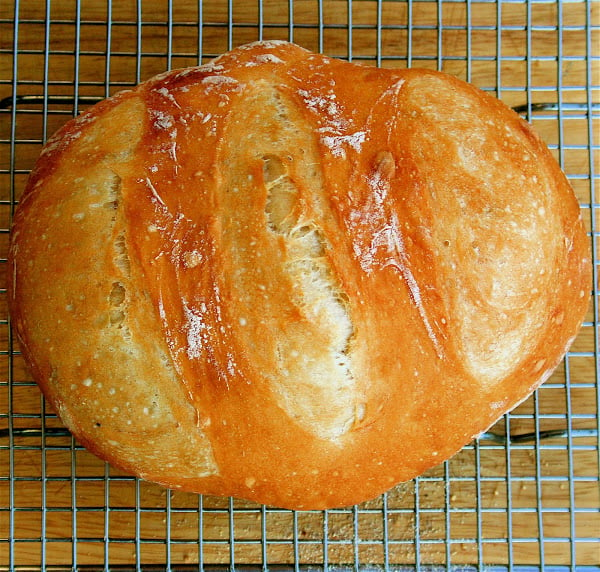
I thought this last idea sounded a little odd. With bread often being one of the least expensive items at the market, surely, I thought, their are better ways to save money.
I decided to investigate. Over the weekend, I made a visit to Henry’s Market (to purchase goat’s milk for a rosemary-gelato round two attempt) where I recorded some prices. A one-pound loaf of La Brea bread (the gourmet bread created by Nancy Silverton sold at grocery stores nationwide) costs on average $5.35. (To give you a range, the least expensive La Brea Country White Sourdough loaf cost $3.99 a pound and the most expensive Olive loaf cost $6.99 for 14.5 ounces.) Now, La Brea bread is one of the more expensive varieties of bakery-style bread found at grocery stores, but it’s also one of the best, and I’ve chosen to use it as the measure in this experiment for that reason.
Now, on to Artisan Bread in Five Minutes a Day. I’ve been meaning to open this book since receiving it at Christmas from my father-in-law, who had read about it in this November 2007 NYTimes article: “Soon The Bread Will Be Making Itself”. Seriously, after I made the initial batch of starter, the bread took no more than five minutes of active time to prepare. (Plan on a 40 minute rise plus a 30 minute bake). And the result? Five stars. Ben and I ate almost an entire one-pound loaf in one sitting.
Preparing the loaves is so simple that I made bread on both Saturday and Sunday nights of this weekend, and I still have enough starter to prepare two more loaves this week. The starter keeps for at least two weeks in the refrigerator. This method, created by Jeff Hertzberg, a physician from Minneapolis, entails no kneading and can be prepared by the most novice of bread makers. If you have any inkling to learn to make bread or if you are a pro and desire a simpler method, buy this book: Artisan Bread in Five Minutes a Day: The Discovery That Revolutionizes Home Baking.
So, what does one of these loaves cost to prepare? Using the price of flour given by the American Farm Bureau — a 5-lb. bag of flour costs on average $2.39 — and prices for yeast and salt listed at Henry’s Market — a 3-lb. pound box of kosher salt costs $3.49 and a three-pack of yeast costs $2.39 — a one-pound loaf of homemade artisan bread costs about 60 cents to prepare from scratch. (Flour costs about 3 cents per ounce; yeast, 35 cents per teaspoon; and salt, 1 cent per teaspoon.) Using Henry’s Market prices, too, this estimate of 60 cents is likely on the high side.
The average price of a loaf of La Brea bread is almost nine times more expensive. Even the cheapest loaf of bakery-style bread, priced at $1.29 a pound, costs over twice as much as a loaf of homemade bread. Upon closer analysis it seems the man who called into the radio program actually might be on to something.
Even if saving money is not your goal, however, give this recipe a stab purely to experience how truly simple bread making at home can be. I’m dying to try other recipes in this book such as roasted red pepper fougasse, Italian semolina, and sun-dried tomato parmesan but for now, I’m extremely happy with the results of this master boule: It’s perfectly salty, moist and airy and delectable all around.
We ate three-quarters of this loaf in one sitting. It’s so yummy!

The Master Recipe: Boule
- Yield: 4 1-lb loaves
Description
Adapted From Artisan Bread in Five Minutes A Day by Jeff Hertzberg and Zoë François
Ingredients
- 3 cups lukewarm water
- 1½ T. granulated yeasts (1½ packets)
- 1½ T. kosher or other coarse salt
- 6½ cups (29.25 oz.) unsifted, unbleached, all-purpose white flour, measured with the scoop-and-sweep method
Instructions
1. Warm the water slightly: It should feel just a little warmer than body temperature, about 100ºF.
2. Add yeast and salt to the water in a five-quart bowl, or preferably, in a resealable, lidded (not airtight) plastic food container or food-grade bucket. Don’t worry about getting it all to dissolve.
3. Mix in the flour: Add all of the flour at once, measuring it with dry-ingredient measuring cups, by gently scooping the flour, then sweeping the top level with a knife or spatula; don’t press down into the flour as you scoop or you’ll throw off the measurement by compressing. Mix with a wooden spoon. If necessary, reach into your mixing vessel with very wet hands and press the mixture together. Don’t knead! It isn’t necessary. You’re finished when everything is uniformly moist, without dry patches. Dough should be wet and loose enough to conform to the shape of the container.
4. Allow to rise: Cover with a lid (not airtight) that fits well to the container you’re using. Allow the mixture to rise at room temperature until it begins to collapse (or at least flattens on the top), approximately two hours. You can use a portion of the dough any time after this period, but fully refrigerated dough is less sticky and is easier to work with. So, the first time you try this method, it’s best to refrigerate the dough overnight before shaping a loaf.
On Baking Day:
5. Sprinkle the surface of your refrigerated dough with flour. Pull up and cut off a 1-pound (grapefruit-size), using a serrated knife. Hold the mass of dough in your hands and add a little more flour as needed so it won’t stick to your hands. Gently stretch the surface of the dough around to the bottom on all four sides, rotating the ball a quarter-turn as you go. The correctly shaped final product will be smooth and cohesive. The entire process should take no more than 30 to 60 seconds.
6. Place the shaped ball on a cornmeal-covered pizza peel. (If you aren’t planning on baking the bread on a pizza stone, just let the dough rest on a cornmeal-covered cutting board. Allow the loaf (uncovered) to rest on the peel for about 40 minutes.
7. Twenty minutes before baking, preheat the oven to 450ºF, with a baking stone placed on the lowest rack. (If you don’t have a stone, don’t worry.) Place an empty broiler tray for holding water on any other shelf that won’t interfere with the rising bread. (This helps to make the crust crispy, but your bread will still be delicious if you omit this step.)
8. Dust the top of the loaf liberally with flour, which will allow the slashing knife to pass without sticking. Make several ¼-inch-deep slashes across the bread. (Again, if you omit this step, your bread will taste the same.)
9. With a quick forward jerking motion of the wrist, slide the loaf off the pizza peel and onto the preheated stone. (Alternatively, butter a Pyrex dish or baking pan and place the bread in the pan.) Quickly but carefully pour about one cup of hot tap water into the broiler tray and close the oven door to trap the steam. Bake for about 30 minutes, or until the crust is nicely browned and firm to the touch. Allow to cool completely, preferably on a wire rack.
If you bake frequently, purchase yeast in bulk bags and store in your refrigerator or freezer in an airtight container. You’ll save a ton of money:
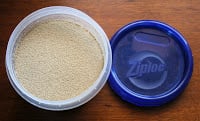
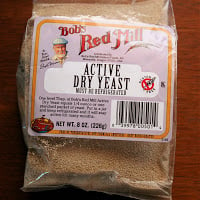
Here are two shots of an unslashed loaf baked in a buttered one-quart Pyrex dish. The difference in crust texture, in my opinion, is indetectable. If you don’t have a pizza stone and don’t feel like going through the trouble of a steam tray, this method, outlined in the recipe, works just fine.
This post may contain affiliate links. Please read my disclosure policy.

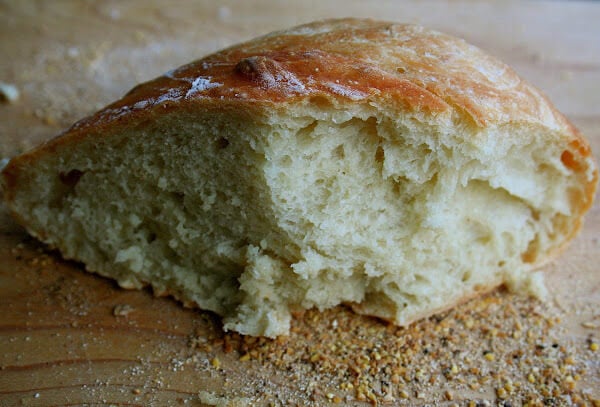
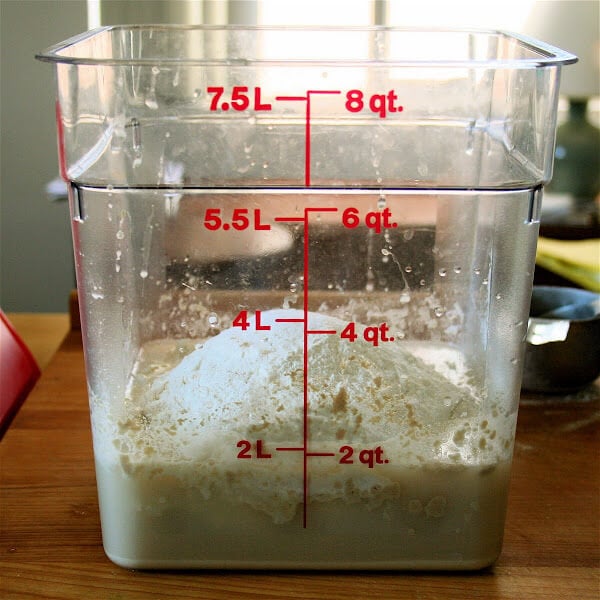
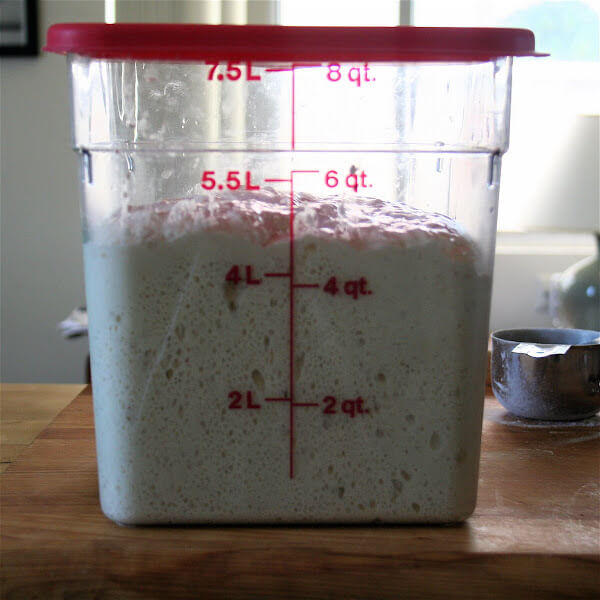
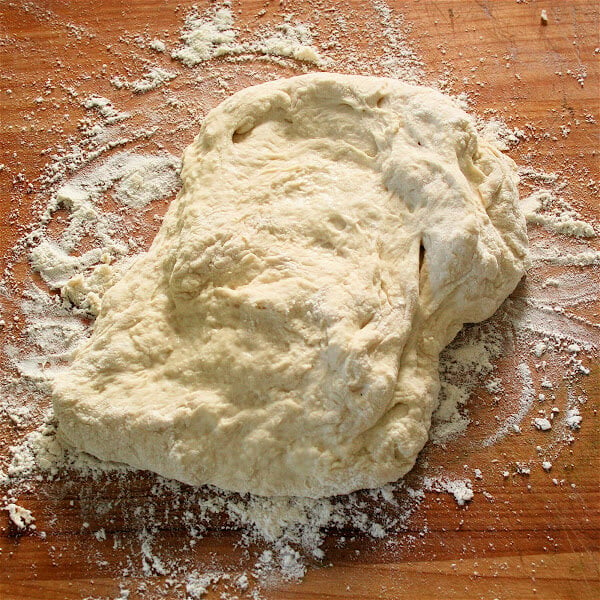

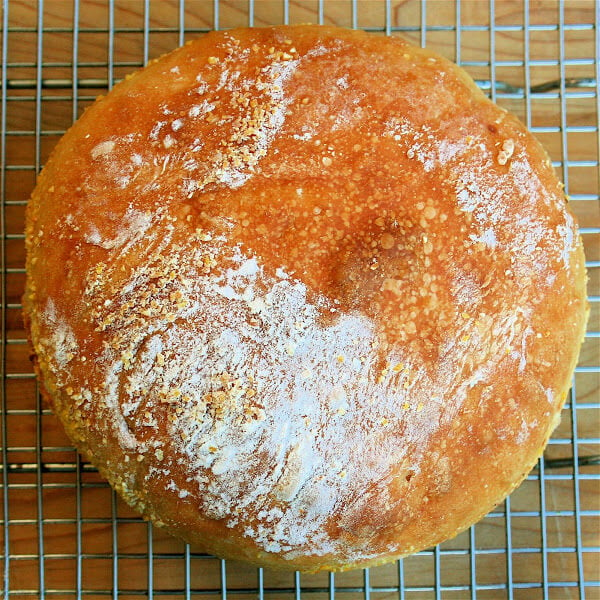
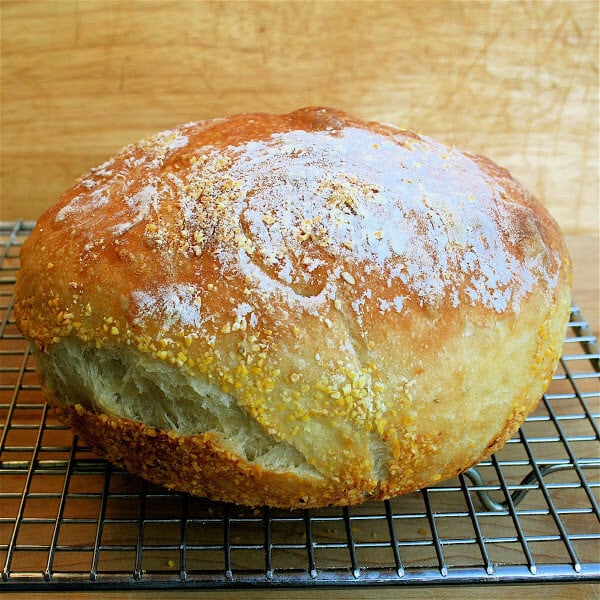
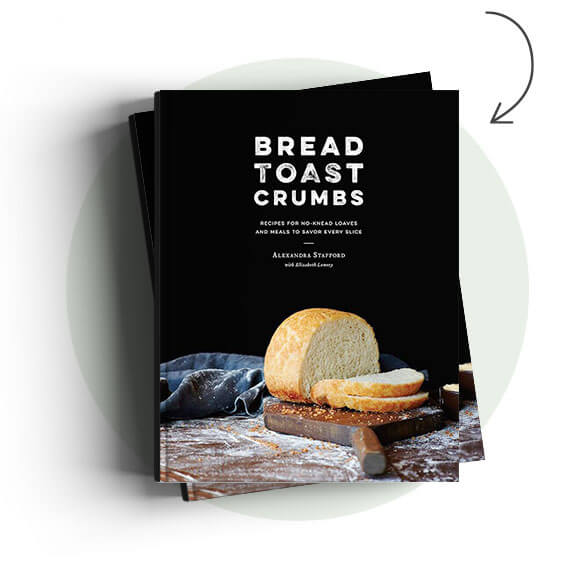




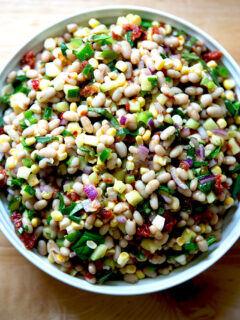
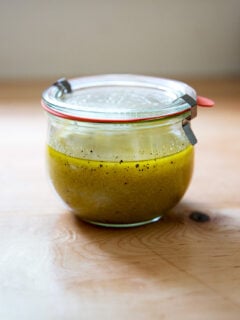
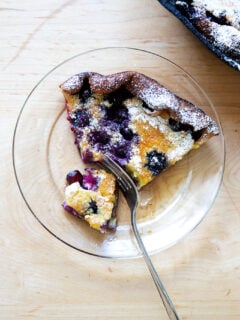


173 Comments on “Artisan Bread In Five Minutes A Day, Seriously”
I’m late to this post but I see other people are still visiting it as well. This bread turns out great, with almost no effort. I bought the book after trying it out. I cook mine in a Dutch Oven that’s been preheated in the oven; this steams the bread. Use parchment paper to drop the bread into the hot dutch oven, and the parchment then serves as a nonstick surface (I believe Cook’s Illustrated came up with this method)
Hey Alexandra, the loaves look gorgeous!!! Would this dough work as a pizza base?? Have you tried it?
I found your web-site through the NYTimes article. I have to give you the biggest THANK YOU note ever – because this recipe changed my family’s quality of life immensly for the better. We make this bread probably every other day, and it’s just perfect. Thank you sooooooooo much!!!
I’m excited to try this. Didn’t have a suitable lidded container and am waiting for the one I ordered on line.
when i leave it to rise, it doesn’t “rise” upwards, but spreads to the sides… is my dough too thin?
should incorporate more flour
hmmmm. How is it turning out when it bakes? I wouldn’t worry too much about how it looks when it rises if it turns out OK when it bakes. But, it does as though you could incorporate a little more flour. The dough definitely is wet and sticky but it shouldn’t be too thin that it can’t hold its shape. Does that make sense?
Hi Alexandra,
It turned out awesome and even better than I expected, I guess I couldn’t shape the dough easily, so that caused it to spread sideways. I’m making this again today and carefully about the measurements.
Thanks:)
Hi Alexandra,
Sorry one more question?
yesterday i made the bread and i used half whole wheat. it was dense. is it supposed to be dense because of whole wheat? or may be because of oven temperature?i baked at 425 f for 30 mins. it tasted great anyways, but i just wanted to make sure i did it right.
thanks.
I’m a homeschooling mom. This week, my kindergarten daughter was learning about bakers. What a wonderful experiment for us to do! She loved watching the bread “grow”. Getting our hands “goopy” when we mixed the dough together was fun! We didn’t have any cornmeal on hand, but sesame seeds were a great alternative! It even made the loaf have a wonderful nutty taste! I’m off to purchase this book for my iPad now. Thank you for making it look so simple! It truly is as easy as you described.
KatieBeth, this makes me so happy! And you inspired me to make a batch of bread today… husband and daughter are very happy now too. Thanks!
Tried this with rosemary and got rave reviews. A nice twist on the original. Thanks for the inspiration!
This looks delish!
I have a question though…and maybe I am just not fully understanding bread making because I have never really baked bread.
You said that (after you refrigerate the dough) you cut off a grapefruit sized piece. Do you return the rest of the dough to the fridge? How long does the dough last for? Or do you use the entire piece of dough to make the bread?
Thanks for the clarification!
Hi Ashley,
Yes, after you cut off the grapefruit sized piece of dough, return the rest of the dough to the fridge. According to the book, you can store the bread for as long as 14 days in the fridge. I’ve never stored mine for that long, but apparently you can! The books says to store the dough in a lidded but not airtight container. Hope that helps!
A woman from our church did a wonderful class taken from this idea and from the Book that you mention. We had some samples and it was amazing!!! I haven’t tried it yet because I Love homemade bread and am trying to lose weight right now. A friend posted a link to one of your recipes and I found your blog. Your food photography is beautiful! Your site makes me hungry. In fact, my daughter is a lead designer at Sommerset Studios. One of the magazines they publish is “Where Women Cook.” Have you seen it? You ought to be featured in there. Let me know if you are interested.
thanks.
Thank you, Lisa, you are very nice to say so. I have never seen the publication you have mentioned, but it sounds so interesting, and of course, I would love to learn more. Thanks for getting in touch!
I make this bread at least once per week. The family loves it. Taught my friend how to make bread using this recipe. So noob-friendly! Thank you for sharing and documenting with such detail!
Hi,
Your bread looks delicious!
I have a question: do you mean table spoons or tea spoons for the yeast and salt?
Thanks! 🙂
Mafalda — Sorry to be getting back to you so late! The “T” is for tablespoons.
You should make a video, I would be your first customer. I am going to try this the way I read it and hope it comes out, just don’t seem like something so siple could be so good
I don’t understand about the container.or the top. Could you please explain? Can’t wait to try.
Linda — The recipe makes a large quantity of dough, so it’s helpful to have a large vessel on hand (such as the one pictured) to both mix and store the dough in — fewer dishes if you can mix the dough in the same vessel that you store it in. And the instructions say to leave the lid just slightly ajar or at least not slammed tightly shut. Does that make sense? Let me know if I can answer any more questions.
Has anyone tried this recipe/method with whole wheat flour, or a mix of 1/2 & 1/2?
Jessie, I have tried this with whole wheat, a mix of 1/2 and 1/2, and bread flour. All of them turn out great, it’s just a matter of taste preference.
Mary and Jessie — Thank you Mary for answering Jessie’s question. I would agree with Mary. The bread turns out great, but it really is a matter of taste preference — the whole wheat flour makes the dough just a touch heavier/denser, but it is still delicious. I actually almost always add a little whole wheat flour. I do it by weight, so I can’t say exactly how many cups, but I would guess that a quarter of the flour percentage is usually whole wheat. Hope that helps!
Thank you Mary, I cant wait to try this!
Hi, this seems like a great recipe. I cut it in half… and I am cooking the whole thing…. should I still only cook it for 30 minutes?
Jordana — You’ve probably already baked your loaf, but I wanted to get back to you anyway. So, did you bake one giant loaf? I’m a little confused — did you cut the whole recipe in half and then bake off that portion of dough in one loaf? Let me know, and then I can address the cooking time a little better. If you made a really large loaf, it probably would take closer to 45 minutes to cook.
Can u make a whole wheat version on this and will it take away from the flavor?
Cindy — yes, but I wouldn’t substitute all of the white flour for whole wheat the first time you try the whole wheat variation. Start with substituting half of the flour for whole wheat. The flavor is still wonderful, but the bread definitely becomes a little denser/healthier tasting. Still delicious, just different.
Hi, Alexandra. Just discovered your blog via Creature Comforts (which linked to your recipe for fries). Awesome! I realize I’m late to the “party” on this one, but was wondering if you could tell me where you purchased the container? It looks ideally suited to this process.
Thanks so much. I can’t wait to explore your entire blog. The recipes and pictorals are beyond tantalizing!
Best regards,
Didi
Hi Didi,
Welcome! Those storage containers are the best. We used them at the restaurant I worked at many years ago now, and I can’t live without them. They are made by Cambro, but it doesn’t look as though you can order them online from the Cambro website. You can order them from Amazon, however. I have about 4 each of the 8 quart and 4 quart storage containers. They are so sturdy and will last forever. I love the big opening. Here’s a link to the 8qt: https://www.amazon.com/gp/product/B001E0JM9A/ref=as_li_qf_sp_asin_tl?ie=UTF8&tag=alexandrask06-20&linkCode=as2&camp=1789&creative=9325&creativeASIN=B001E0JM9A
Thanks for writing in!
Hello Alexandria,
I stumbled on your site the other day and I just gave this bread a shot. I had a few things happen differently than you and I was wondering if you had any advice for me. The first was that my dough in the fridge looked just like yours but once it finished rising in was probably only about 2.5 L to 3 L much smaller than what you have. The second thing, when I cooked my bread the outside was perfect but the inside of the bread seemed a little undercooked and the bottom 1/4″ – 1/2″ was dense raw-ish dough. It doesn’t seem as if my bread is rising evenly? Even with these little issues the bread was delish (I just cut off the bottom bit) and super easy. Thanks for the recipe!
Ellen, hi, sorry to hear this recipe is giving you a few issues. OK, first of all, I have one question for you. When you do the initial rise, do you do this at room temperature or in the fridge? If you let it rise in the fridge, it will take much longer for the bread to reach its maximum rising height. I always let the bread rise at room temperature first, then chill it after it has reached the desired height. My next tip would be to mix the yeast with the flour first, then add the salt, then add the water — salt can kill yeast, and while apparently mixing the flour and the yeast separately first is unnecessary, I almost always do so because I never want to take the risk. Finally, another question, when you set out to shape/bake the loaves, how long do you let them sit at room temperature before baking them? It does sound as though the bread is not rising evenly. I would make sure you are allowing the loaf to rise the full 40 minutes before baking. One final note, I do find that I have the best results with this dough if I use it up within the first 5 days or so. After that, it never seems to rise as well as it did the first few days. Hope that helps. Let me know if you have any other questions!
Hi…Love this recipe however I, too, was having issues with the dough rising … I just made my fifth batch of dough (as the first four batches were devoured by family) and I wish I would have read this comment earlier as I think the salt is affecting the yeast. I have made breads for years and I know this dough should rise more than I am seeing it and I have adhered to the rising times exactly as stated in the recipe. This time, I immediately mixed the liquid (water, salt and yeast) into the flour so I do not think the salt and yeast mixture had time together enough to ruin the effect of the yeast, and I am eager to see how it rises… if I have the same issue, I will make another batch of dough with your suggestion to separate yeast and salt… Everyone LOVED this recipe!!
Tried this bread and everyone LOVED it. Just ordered the cookbook. Can’t wait to try some other recipes from this book.
Karen, so happy to hear this! Isn’t it fun?!
I’ve never made bread but this is really tempting my tastebuds!! I LOVE fresh-baked bread. Problem is I’m single with a roommate, so large quantities are not very practical and fridge space is limited. Can you freeze this dough or bake your loaf 20 mins and freeze the semi-baked loaf and then bake the frozen loaf for an extra 15 mins or however long until it’s done?
I’m just trying to figure out how to deal with so much dough… apart from making half of the recipe. It would be nice to not have to go through the whole process everytime I want to bake only 1 loaf.
Luvie — Before I get to your questions, did you see this post: https://alexandracooks.com/2012/11/07/my-mothers-peasant-bread-the-best-easiest-bread-you-will-ever-make/
It sounds like it might be a better fit given your living situation. It is so good and so easy and makes two nice boules, one for you, one for your roommate.
As for the other questions, I have never tried the parbaking, but I think it’s worth a shot. Or just bake it completely and freeze it once it cools. Bread freezes really nicely, even when it’s fully baked. I think you can halve this recipe, too, with success but you still are left with a fair amount of dough, which doesn’t sound ideal for you, but a half recipe yields about 3 loaves, which you can bake over the course of a few days, so that might be worth trying.
HI a question about the cups used, did you use 8 ounce cups, the math isn’t adding up in ounces, 6 and a half cups would be 52 oz I am wanting to make this and do not want to mess this up. Thanks for your input.
Internetrecipes — Ok, so I think you are confusing measuring by weight vs. measuring by volume. 1 cup of flour weighs differently than 1 cup of water, than 1 cup of sugar, than 1 cup of rice, etc. The 1 cup vessel (even if it says 8 oz.) is a volume measurer — not every 1 cup will weigh 8 ounces. Does that make sense? So, because 1 cup of flour generally weighs 4.5 oz, 6.5 cups of flour will weigh 29.25 oz. If you don’t have a scale to weigh the flour, use your 1 cup measurer, which should have a line denoting the one cup mark, and if it doesn’t, the top of the cup is the one-cup line. I hope that makes sense. Let me know if you have any other questions.
Yes it does, thank you for getting back to me. Since you had the oz in parentheses it confused me as I am new to the baking world. 🙂
Internetrecipes — sorry for the confusion! And glad to help! Let me know if anything else comes up.
Can u use bread flour?
Eileen — yes, definitely!
This bread is amazing and was super easy to make! We made grilled cheese sandwiches and tomato bisque soup and they were so yummy!! The perfect meal for a blizzardy night! Thank you!
Liz — wonderful to hear this! I know, is there anything like fresh bread on a blizzardy night?
Hi, I have really enjoyed checking out your recipes over the last few months—gorgeous photos and yummy inspiring recipes! The peasant bread has been one of my favorites, but I wanted to try this one for something new. I was wondering if the second rise (40 mins rest after refrigeration) is supposed to get it puffed up to double in size or just relax the dough and take off the chill. Mine definitely did not double even after I left it a little longer than 40 minutes, but I decided to cook it anyway. I thought I’d check before doing the second one. Thanks so much for a great blog!
Deb — First of all, thank you so much for your nice comment. I am glad you are enjoying the recipes. I don’t think that the dough will in fact double in size during those 40 minutes. It should definitely relax and puff up slightly, but (and I haven’t made this recipe in awhile now) I don’t recall it ever really doubling. How did it end up turning out for you? Just FYI, I do remember having more trouble with the loaves puffing up and baking properly the longer the dough sat in the fridge, so on day 4 and 5 for example.
Thanks so much for the response! The bread turned out tasting great, but definitely did not puff up a whole lot during the rise. I ended up baking both loaves from my half-recipe in the same day so I don’t think it had more than 24-36 hours in the fridge. If it just doesn’t make a huge loaf, then it was probably okay. I think I was just expecting it to end up more like the peasant bread! Anyway, it was super easy and delicious. My weather was also a little damp and cold so maybe that affected it’s rise? Well, thanks again.
Hi Deb — I think the cold weather could have played a roll, but the subsequent rises are a little tricky with that recipe. I haven’t made this recipe since we were in CA, which is almost two years now, so I’m a little out of practice, but it sounds as though you did everything you could to get the best possible loaves. I’m glad the taste was good — it’s definitely different than the peasant bread. What I love about the peasant bread is that the Pyrex bowls always reliably create a nice round boule. Thanks for reporting back!